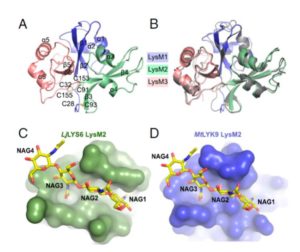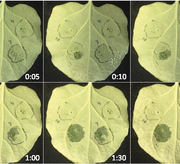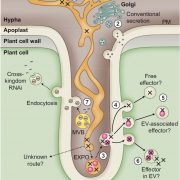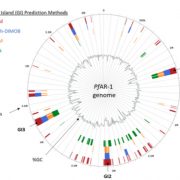Receptor-mediated chitin perception in legume roots is functionally separable from Nod factor perception ($)
 Small molecules are crucial for the recognition of friends and foes. For example, Nod factors are N-acetylglucosamine-derived “friend” signals produced by bacterial microsymbionts. Chitin is an N-acetylglucosamine-derived fungal wall polymer that plants perceive as indicating the presence of an enemy. The question of how plants perceive their friends and enemies became even more perplexing when it was recognized that Nod factors and chitin are recognized by closely-related lysine-motif (LysM) receptors. Bozsoki et al. used two model legumes, Lotus japonicus and Medicago truncatula to dissect the functions of different LsyM receptors. They showed that LjLYS6 binds with high affinity to chitin oligomers, whereas previous studies showed high-affinity binding of LjNFR1 and LjNFR5 to Nod factors. They further showed that mutants of Ljlys6 and its ortholog Mtlyk9 are impaired in defense responses, but showed no difference from wild-type in symbiosis phenotypes. These data indicate that although related, different LysM genes have fundamentally different roles in friend-versus-foe recognition. Proc. Natl. Acad. Sci. USA 10.1073/pnas.1706795114
Small molecules are crucial for the recognition of friends and foes. For example, Nod factors are N-acetylglucosamine-derived “friend” signals produced by bacterial microsymbionts. Chitin is an N-acetylglucosamine-derived fungal wall polymer that plants perceive as indicating the presence of an enemy. The question of how plants perceive their friends and enemies became even more perplexing when it was recognized that Nod factors and chitin are recognized by closely-related lysine-motif (LysM) receptors. Bozsoki et al. used two model legumes, Lotus japonicus and Medicago truncatula to dissect the functions of different LsyM receptors. They showed that LjLYS6 binds with high affinity to chitin oligomers, whereas previous studies showed high-affinity binding of LjNFR1 and LjNFR5 to Nod factors. They further showed that mutants of Ljlys6 and its ortholog Mtlyk9 are impaired in defense responses, but showed no difference from wild-type in symbiosis phenotypes. These data indicate that although related, different LysM genes have fundamentally different roles in friend-versus-foe recognition. Proc. Natl. Acad. Sci. USA 10.1073/pnas.1706795114









